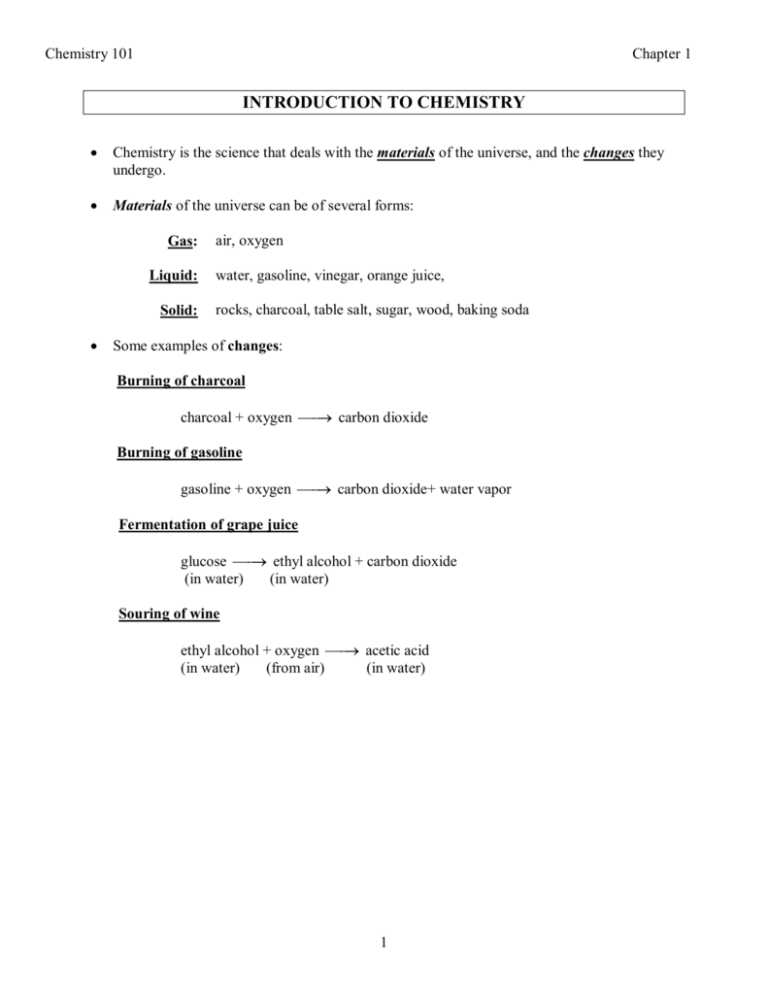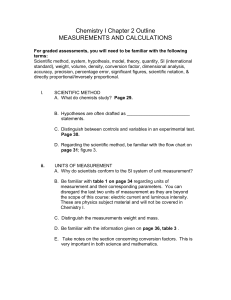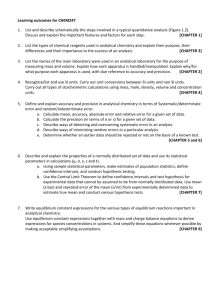Chem.101 Ch. 1A
advertisement

Chemistry 101 Chapter 1 INTRODUCTION TO CHEMISTRY · Chemistry is the science that deals with the materials of the universe, and the changes they undergo. · Materials of the universe can be of several forms: Gas: air, oxygen Liquid: water, gasoline, vinegar, orange juice, Solid: rocks, charcoal, table salt, sugar, wood, baking soda · Some examples of changes: Burning of charcoal charcoal + oxygen ¾¾ ® carbon dioxide Burning of gasoline gasoline + oxygen ¾¾ ® carbon dioxide+ water vapor Fermentation of grape juice glucose ¾¾ ® ethyl alcohol + carbon dioxide (in water) (in water) Souring of wine ethyl alcohol + oxygen ¾¾ ® acetic acid (in water) (from air) (in water) 1 Chemistry 101 Chapter 1 SCIENTIFIC METHOD Ø is a general, overall philosophy of approach to the study of nature Ø a formal statement of the steps that any of us follow as we logically approach a problem EXPERIMENTS Observation of natural phenomena carried out in a controlled manner so that the the results can be duplicated and rational conclusions obtained RESULTS HYPOTHESIS A tentative explanation of some regularity of nature FURTHER EXPERIMENTS devised based on hypothesis NEGATIVE RESULTS POSITIVE RESULTS Lead to modification or rejection of hypothesis and formulation of new hypothesis Support hypothesis THEORY Follows after results consistently support a hypothesis A tested explanation of basic natural phenomena FURTHER EXPERIMENTS NATURAL LAW A statement that summarizes facts that come from many experiments 2 Chemistry 101 Chapter 1 LAW OF CONSERVATION OF MASS Antoine Lavoisier (1743­1794) ­ studied chemical changes ­ pioneered the use of balances in chemical research ­ weighed the substances before and after a chemical change ­ studied the process of burning (combustion) SHOWED THAT WHEN A MATERIAL BURNS, A COMPONENT OF AIR (HE CALLED IT OXYGEN) COMBINES CHEMICALLY WITH THE MATERIAL. Examples: 1. Mercury is heated in air to form mercuric oxide Mercury + Oxygen ¾¾> 200.6 g ? ¾¾> 200.6 g ? ¾¾> 200.6 g + 16.0 g ¾¾> Mercuric Oxide more or less than 200.6 g ? 216.6 g 216.6 g 2. When sugar is heated it forms carbon and water vapor. Will the carbon weigh more or less than the sugar? sugar ¾¾> 34.2 g 34.2 g carbon 14.4 g 14.4 g + water (g) ? 19.8 g THE TOTAL MASS REMAINS CONSTANT DURING A CHEMICAL CHANGE MASS vs. WEIGHT MASS · · · · · · The quantity of matter in an object Independent of location on earth Measured in grams (g) or kilograms (kg) Measured on a balance (massing) Commonly used in chemical laboratory Sometimes mistakenly referred to as weight WEIGHT · The force of gravity exerted on an object · Depends on location on earth (the closer to the center of the earth, the more the object weighs) · Measured in Newtons (N) · Measured with a spring scale (weighing) 3 Chemistry 101 Chapter 1 PHYSICAL & CHEMICAL PROPERTIES · The characteristics of a sample are its properties. PHYSICAL PROPERTIES CHEMICAL PROPERTIES · A property that can be observed without changing the chemical identity of the sample of matter · A property that refers to the ability of a substance to form different substances Examples: · Physical state (solid, liquid, gas) · Odor · Color · Melting point · Boiling point · Density · Specific heat Examples: · Charcoal burns in air · Iron rusts · Grape juice ferments · Wine sours · Alcohol is flammable Examples: Identify each of the following properties as physical or chemical: 1. Oxygen is a gas 2. Helium is unreactive 3. Water has a high specific heat 4. Gasoline is flammable 5. Sodium is soft and shiny 4 Chemistry 101 Chapter 1 PHYSICAL & CHEMICAL CHANGES PHYSICAL CHANGES · A change in the form of matter but not in its chemical identity Examples: · Freezing of water · Boiling of water · Melting of ice · Evaporation of alcohol · Sublimation of dry ice CHEMICAL CHANGES (REACTIONS) · A change in which one or more kinds of matter are transformed into a new kind of matter or several new ones Examples: · Souring of wine · Rusting of iron · Burning of alcohol · Explosion of a firecracker · Electrolysis of water Physical Changes Chemical Changes Examples: Identify each of the following changes as physical or chemical: 1. Cooking food 2. Mixing sugar in tea 3. Carving wood 4. Burning gas 5. Food molding 5 Chemistry 101 Chapter 1 CLASSIFICATION OF MATTER I. II. By Physical State By Chemical Constitution I. CLASSIFICATION OF MATTER BY PHYSICAL STATE Solids · · · · · Fixed volume Fixed shape Maintain their shape Are rigid Incompressible Liquids · · · · · Fixed volume No fixed shape Flow Are fluid Incompressible Gases · · · · · No fixed volume No fixed shape Flow Are fluid Compressible NOTE: 1. 2. The three forms of matter (solid, liquid, gas) are referred to as states of matter This classification is not very meaningful, since the majority of the different forms of matter may exist in all three physical states, depending on conditions. Example : water can exist as: 1. solid water (ice) at very low temperatures (below 0 0 C) 2. liquid water (between 0 0 C and 100 0 C 3. gaseous water or water vapor (above 100 0 C) The term vapor is used to refer to the gaseous state of a form of matter that exists as a solid or a liquid at room temperature (25 0 C) 6 Chemistry 101 Chapter 1 II. CLASSIFICATION OF MATTER BY CHEMICAL CONSTITUTION MATTER can be separated by physical processes SUBSTANCES MIXTURES (filtration, distillation, chromatography) Forms of matter with constant composition and fixed properties Forms of matter with variable composition; Properties depend on composition. can be separated ELEMENTS by chemical changes Substances that cannot be decomposed by any chemical reaction into simpler substances Examples: H, O, C, N, Na Cl, Hg , Al, I, Au, Pb, Cu Ag, P, He, Mg, Fe COMPOUNDS Substances composed of two or more elements chemically combined. Examples: water, sugar, carbon dioxide, ammonia, glucose, sodium chloride 7 HOMOGENEOUS HETEROGENEOUS (same throughout) (different throughout) SOLUTIONS soil, orange juice Solid: bronze, brass Liquid: wine, vinegar Gaseous: air Chemistry 101 Chapter 1 MEASUREMENT · Is the comparison of a physical quantity with a unit of measurement. Example: The mass of the same penny is measured by 3 different students on the same balance: m1 = 3.11 g m2 = 3.12 g m3 = 3.13 g The mass of the penny is reported as : 3.12 g we are sure of this digit this digit is accurate (certain) the accuracy is ± 0.1 g we are not sure of this digit this digit is uncertain the uncertainty is ± 0.01 g The mass of the penny should be reported as : (3.12 ± 0.01) g the uncertainty of the measurement (normally not shown, but implied) · The three student obtained measured values which are very close to each other. · We say that their measurements had good REPRODUCIBILITY or had good PRECISION 8 Chemistry 101 Chapter 1 PRECISION: – is a determination of the reproducibility of a measurement. – tells you how closely several measurements agree with one another. – precision is affected by random errors. ACCURACY: – closeness of a measurement to a true, accepted value. – is subject to systematic errors (errors which are off in the same direction, either too high or too low) Are we confident that the correct mass of the penny is Actually the True Value of the penny is: 3.12 g ? 3.03 g What went wrong? · The balance may not have been zeroed, · The pan of the balance may have been dirty? · This measurement is badly off from the true value Such a measurement is said to have LOW ACCURACY Conclusion: The measurement of the penny as reported (3.12 g) has: Poor Precision Good Accuracy HIGH PRECISION but (measured values are close to each other) Good Precision Good Accuracy Good Precision Poor Accuracy 9 LOW ACCURACY (reported value is far off from true value) Poor Precision Poor Accuracy Chemistry 101 Chapter 1 · Consider that the length of an object is measured with two different rulers: mm (smallest marked unit) 0 1 2 Several observers report: 1.25 cm 1.24 cm 1.26 cm Length should be reported as 1.25 cm (implies ± 0.01 cm) certain digits uncertain digit NOTE: · The accuracy of the ruler is 0.1 cm (1mm) · The uncertainty of the ruler is 0.01 cm (0.1 mm) · One must record the measured value to one more place than the scale is marked cm (smallest marked unit) 0 1 2 Several observers report: 1.3 cm 1.2 cm 1.4 cm Length should be reported as 1.3 cm (implies ± 0.1 cm) certain digit · Precision and accuracy of a measurement are limited by the instrument. 10 uncertain digit






